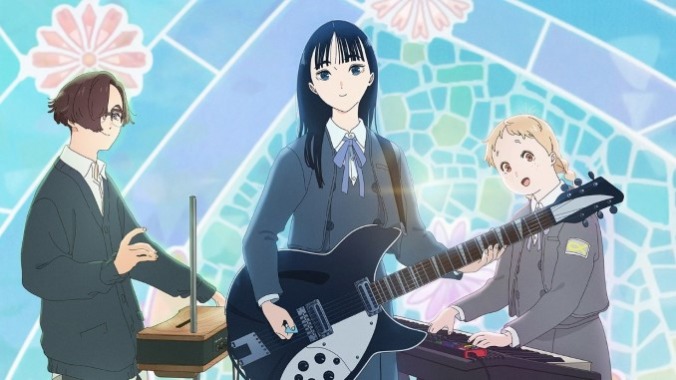The Colors Within Captures the Everyday Magic of Music

When people hear the word “anime,” certain images tend to come to mind: Spiky-haired dudes chucking ki blasts at each other, superpowered pirates sailing the high seas, warriors battling demons with flaming swords, and other maximalist battle-oriented spectacles. But of course, there’s much more to this medium than just burly guys slugging it out (although that can admittedly be quite fun), and one of the best examples of this is the work of director Naoko Yamada. Yamada has made a career out of focusing on the little details, as evidenced by her output at the acclaimed studio Kyoto Animation (K-On!, A Silent Voice, Liz and the Blue Bird, and more). Under the magnifying glass of her compositions, each small gesture takes on added significance, blowing up quotidian concerns to match the larger-than-life emotions of adolescence.
Yamada’s latest, The Colors Within, feels like a logical progression of these tendencies, an animated film about teens that is so attuned to its characters that it finds poetry in everyday moments of connection. It’s about music and the way it can tie people together. It’s about the impermanence of the present and the inevitability of high school coming to an end. It’s about discovering the things that make you, you. On the one hand, not much really happens. But in that absence of “stuff happening,” there are sequences so specific and painstakingly rendered, that these particulars cross over into the universal. If you’ve bounced off Yamada’s output in the past, this flick will probably do little to convince you otherwise, but for fellow fans of this introspective style, her latest has that same deft touch.
The story follows Totsuko Higurashi (Sayu Suzukawa), a high school student attending an all-girls Christian academy in Japan. In many ways, she’s perfectly ordinary. She is doing well enough in school, has a group of close friends, and is a devout Christian like most of her classmates. However, she has a secret: she sees other people as colors. The silhouettes of those around her are filled in with orange, green, and purple splotches. But while her peers have such vibrant colors, for whatever reason, she can’t see her own. One day, Totsuko gets so sucked in by her classmate Kimi Sakunaga’s (Akari Takaishi) dazzling shade of blue that she resolves to get to know her better. Kimi drops out of school, but Totsuko tracks her down to a used bookstore, and after struggling to explain why she followed her there, ends up stumbling into forming a band with Kimi and a gentle boy named Rui Kagehira (Taisei Kido). As the trio practice to participate in a festival at Totsuko’s school, they slowly get to know each other’s problems through music.
Much like how Totsuko’s condition allows her to see the otherwise unremarkable events through a different lens, the film finds magic in commonplace happenings thanks to its sumptuous aesthetic execution. A few years ago, Yamada joined Science Saru, a studio behind some of the most visually experimental anime in recent years, like Ping Pong the Animation, Devilman Crybaby, Your Hands Off Eizouken!, and more. But since joining Science Saru to direct Heike Story and now The Colors Within, Yamada has turned the studio’s explosions of creativity inward, channeling this fervor into subtle character animation that wordlessly communicates what’s just beneath the surface.
Here, bodily motions are portrayed with a fluidity and weight that captures the shape of real movement: fingers flex with the tension of plucking guitar strings, legs restlessly shift in discomfort, and a dress gracefully twirls during an impromptu dance sequence. Although this mode of animation is very technically difficult and decidedly less flashy than what you’ll see in whatever big Shonen Jump adaptation that’s currently airing, this style has long been the bread and butter of Yamada’s old stomping ground, Kyoto Animation, and she’s entirely translated this feel to her latest studio. It’s an approach that pairs perfectly with this film’s quiet narrative ambitions, the emphasis on particulars making each little change in these characters’ lives pop.
Shortly after our main trio forms their band—which is more of a side hobby than a make-it-or-break-it career aspiration—their underlying anxieties come to the fore. Perhaps most pressingly, Kimi dropped out of school without telling her grandmother. Rui loves music but keeps it to himself because he knows his parents expect him to become a doctor and take over their family practice one day. Meanwhile, Totsuko has never told anyone about her condition and is unable to see her own colors due to missing some vital piece of self-actualization.